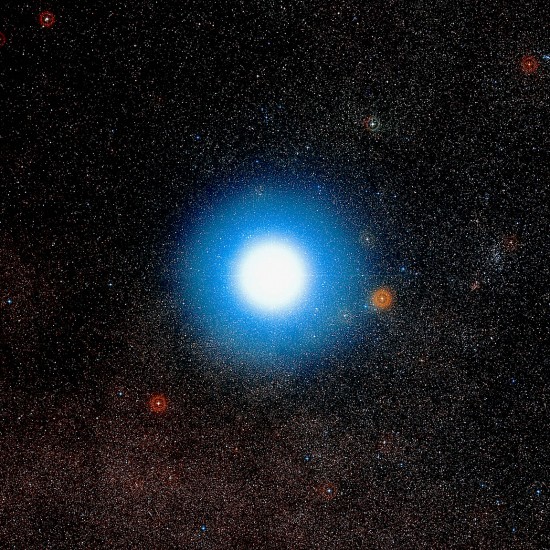
The closest exoplanet is thought to be orbiting Alpha Centauri. Credit: ESO/Digitized Sky Survey 2. Acknowledgement: Davide De Martin
Oct 27, 2014
Are there billions of rocky planets in the galaxy?
“Are we alone in the Universe?” That is probably one of the earliest questions that people ask, after “where do we come from?” According to the European Southern Observatory (ESO), there could be planets galore in our galaxy alone.
Using the High Accuracy Radial Velocity Planetary Searcher (HARPS), the most sensitive spectrograph ever built, called “the planet hunter,” HARPS can analyze stellar spectrograms with a high degree of accuracy. Small Doppler shifts in starlight can be detected, making exoplanet hunting easier.
In the past, attempts to locate planetary bodies in orbit around distant stars suffered from the glare problem: stars are so bright that direct observation of a dim companion is impossible. A little over 16 years ago, astronomer Geoff Marcy announced the discovery of two exoplanets, 47 Ursae Majoris b and 70 Virginis b, both of which were found by analyzing the motion of their primaries.
According the Marcy’s theory, as planets revolve, they pull on their parent stars. The stars “wobble” slightly, altering their spectrographic signatures. Astronomers knew that Doppler shifts could be used to identify binary stars—extremely massive objects—so it was thought that less massive objects could also be identified using that method. The difficulty with the procedure was that even large planets pull on stars by only several meters per second. What was needed was a more detailed picture of stellar spectra, or another way of conducting the search.
NASA launched the Kepler Space Telescope on March 7, 2009 on a three and a half year mission to search for Earth-sized planets around other stars. Before serious problems with spacecraft operations occurred, Kepler identified 989 “confirmed” planets around other stars. Kepler did not use Doppler shift as its means of detection, however. It used a photometer to measure the reduction in light output as an object passes in front of a subject star. Kepler was able to scan 150,000 stars simultaneously utilizing that method. Kepler was re-commissioned for other purposes when its planet-hunting ability ceased in May 2013.
The HARPS instrument is sensitive enough that it can resolve the Doppler shifts of red dwarf stars, as well. Its analysis of 102 different red dwarfs over the last six years revealed nine so-called “super-Earths” (planets 1-10 times the mass of Earth) in the data. Two of them are in the “habitable zones” of their respective hosts. The habitable zone is the range of temperature in which liquid water can exist.
Based on that discovery, ESO scientists estimate that there are “tens of billions” of rocky planets in our galaxy, since red dwarfs are considered the most common star. There are said to be hundreds of red dwarf stars within 40 light years of Earth, so there could also be hundreds of super-Earth planets.
Since many exoplanets are larger than Jupiter, with orbits closer than Mercury is to the Sun, an argument for their creation in stellar electrical expulsion can be made. As Electric Universe advocate Wal Thornhill states: “How else should we expect to find an extrasolar planet whipping around its parent in a few days or in an eccentric orbit? Eccentric orbits should be short-lived. They hint at recent events in those distant planetary systems; perhaps the birth of a new planet.”
Also, as has been presented in previous Picture of the Day articles, rocky bodies, like Mercury or the Moon, are ejected from larger, highly charged objects. Whether they are red or brown dwarf stars, or gas giant planets, planets are not born in dusty eddies surrounding a stellar “cocoon”.
Wal Thornhill again: “It is far simpler and infinitely more efficient if planets are ‘born’ at intervals by the electrical ejection of charged material from the similarly charged interiors of larger bodies – gas giants from stars, and rocky planets from gas giants. We have circumstantial evidence for such a proposal in the binary stars found after a nova outburst. Also most of the rocky bodies in the solar system closely orbit a gas giant. Electrical ejection in a massive internal lightning flash answers the question of the source of the energy. It is not dispersive like an explosion. The electromagnetic pinch effect will produce a jet of matter, rather like a coronal mass ejection, only on a much grander scale. The result is a proto-planet plus a stream of gases and meteoric debris.”
Stephen Smith












